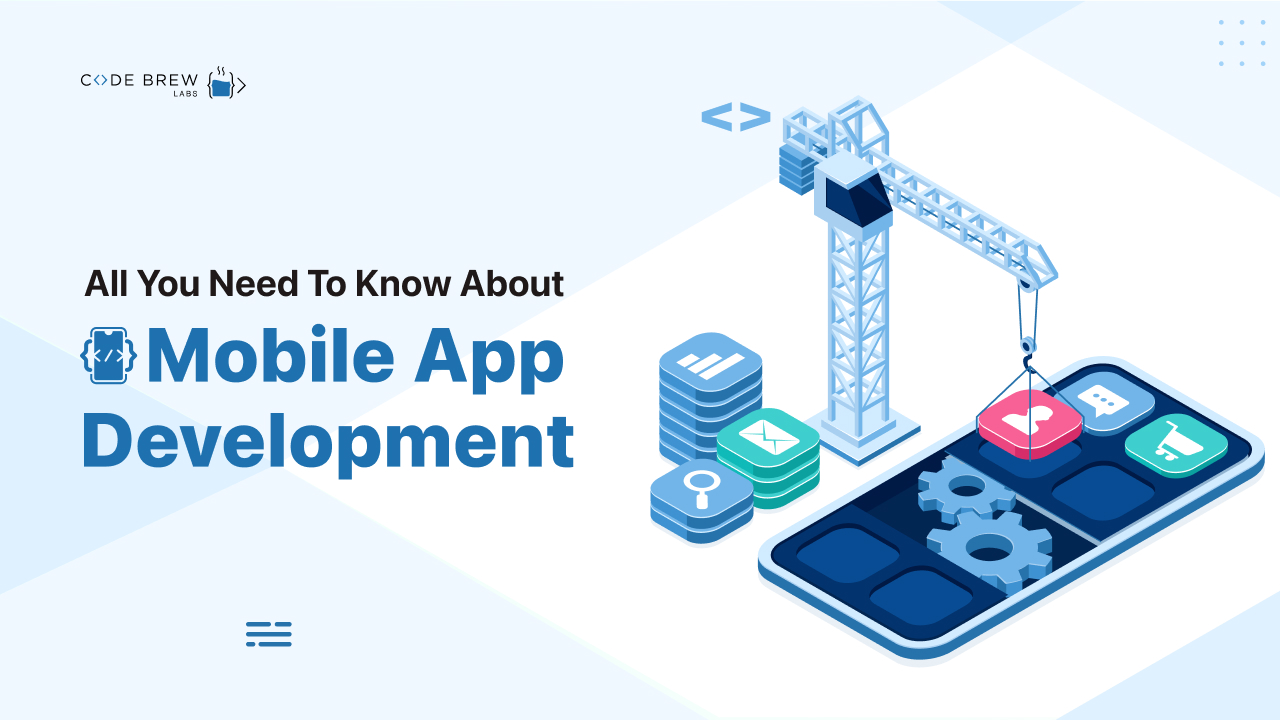
In present times, a business virtually does not exist unless it has a mobile app. Mobile apps have become a necessity for every business, no matter what its type or size. That’s because today, the whole world is online and thus, prefers to conveniently engage, buy, and sell online to save time and money.
Table of Contents
Simply put, people want everything at the tap of a button. And undoubtedly, the Covid outbreak has strengthened this trend of convenience being an absolute need. The numbers validate this point: in 2022, the global mobile application market size was valued at USD 206.85 billion.
But that’s not all. The same report states that the market is expected to grow at a CAGR of 13.8% from 2023 to 2030.
Essentially, mobile app development is the process of building software for smartphones, tablets, and other digital assistants, most commonly for Android and iOS operating systems. The software is either downloaded from an app store or pre-installed on the device or accessed through a mobile web browser.
Typically, a mobile application utilizes a network connection to work with remote computing resources. And as they utilize the in-built features of smartphone devices, mobile apps offer a way better user experience in contrast to mobile web browsing.
And considering that 86.29% of the global population uses smartphones, there’s no looking back when it comes to user penetration in terms of app usage.
It is absolutely crucial to invest in mobile app development services if you want to build a digital presence and eventually, a brand.
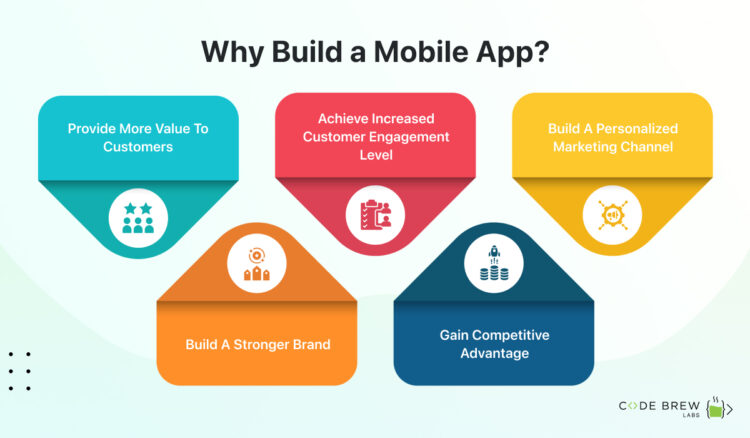
And while there are many reasons for businesses to invest in mobile application development, these more or less fall under these two broad reasons:
A mobile application allows you to attract potential clients by offering them discounts and promotions. You can even send push notifications to inform them about new updates or timely offers.
And notifications work better than other marketing collateral as they have an opt-in rate of up to 70% as compared to emails, for which it is just 5%.
Via mobile applications, people can access your goods and services 24×7 at their convenience. Besides, apps are easier to access than websites and also provide personalized messaging.
It is vital that the mobile app development company you choose follows through with every step of the process. Sprinting over even a single step will bring you back to square one.
Here’s the process:
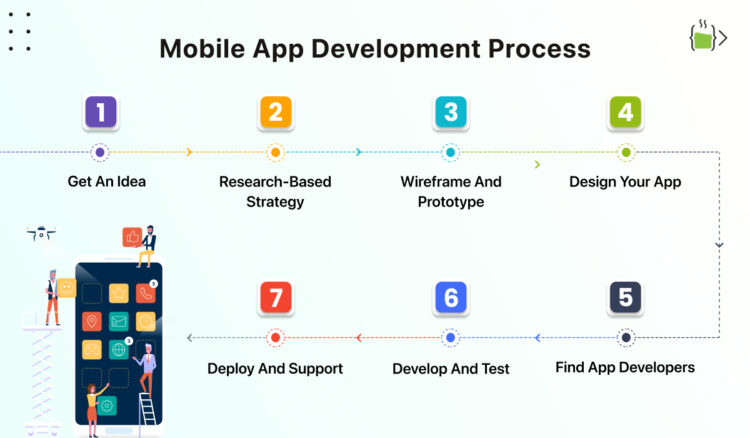
The best approach is to think in terms of real problems and plausible solutions. Make sure your team knows the answer to these questions:
Once the idea is defined, set clear goals:
And then, get to the next stage.
Conduct market research to get an overview of what the users want. This helps you avoid most mistakes and decrease the number of misses during the development process.
To start with, crowdfunding platforms like Kickstarter will help you learn what people are interested in. You’ll see the top funded projects in the mobile application development category and precisely know the greatest ‘inventions’ that have popped up.
And to get a clear understanding of the priorities and why investors back up startups, refer to Crunchbase.
A wireframe is a simplified design of your project. The best (and the recommended) way to bring it to life is on pen and paper.
Setting a wireframe helps you and your mobile development team get a 360-degree vision of functions, uncover interface issues, and get ready for the technical limitations that may pop up in the backend development process.
The users want an app that is easy to use and user-friendly.
User Interface is how your product looks and represents itself in terms of style. User Experience means how the customers feel when they use the product.
Your future app’s success is measured by both, its functionality and attractiveness.
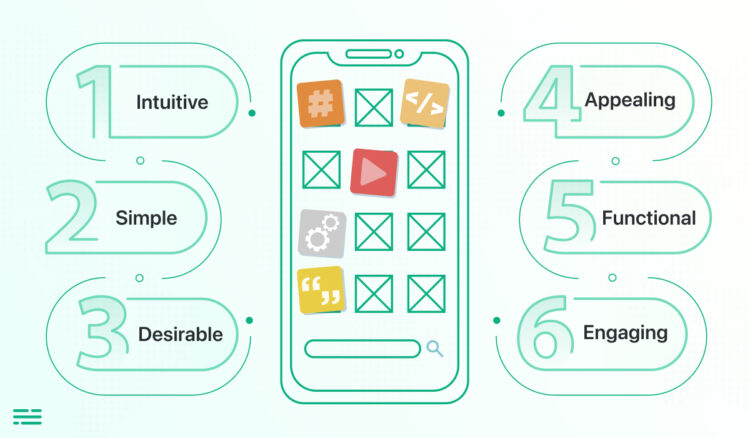
When you do this, make sure you get a clear understanding of the app development process. Also, ensure they have an optimized workflow and use the best technologies for the project.
At your end, you need to check the reviews and create an advanced to-do list including specific tasks, directions, and timeframes.
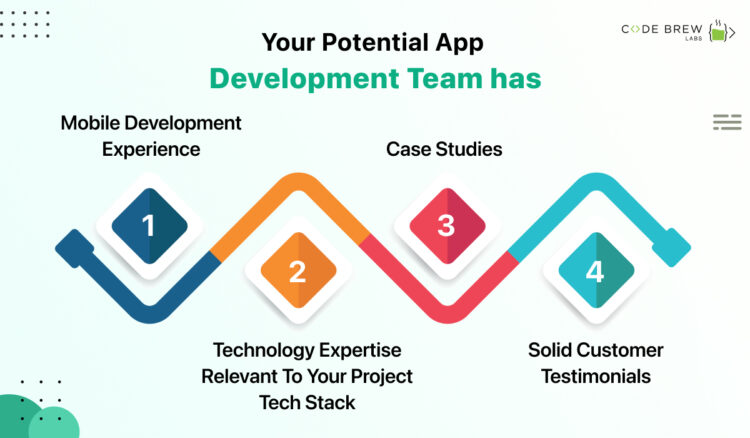
Throughout the development phase, an app goes through many smaller milestones and reiterations. And an app is built following a cyclical process. This is where terms like Sprints, Kanban, Scrum, and Agile methodologies come into the picture.
If your project is such that the user requirements are constantly changing, consider Agile methodology. You can cut down your mobile app development into smaller modules and apply the methodology to each of the small parts.
You’ll need to publish your product on Apple’s App Store or on Google Play Market or both (as per your choice). The launching policies of both these stores are different. To get the confirmation, you’ll have to follow specific procedures.
Further, as users start using your application, the diversity of feedback regarding bugs, updates, and new features will pour in. Here is where your support team will take the lead and bring your app to the center stage.
No matter which app development approach you choose, it’ll have very specific pros and cons. So select an approach that matches your goals.
Only then you will be able to deliver your users the desired user experience and keep them hooked to your app.
| Native Applications | Cross-Platform Applications | Hybrid-Web Applications | Progressive Web Applications |
| These are written in the programming language and frameworks provided by the platform owner and run directly on the device’s operating system like iOS and Android. | These can be written in many programming languages and frameworks but are compiled into a native app that runs directly on the device’s operating system. | These are built using standard web technologies like JavaScript, HTML5, and CSS. They are bundled as app installation packages. Hybrid apps function on a web container that offers a browser runtime and a bridge for native device APIs through Apache Cordova. | PWAs are an alternative approach to traditional mobile app development as there is no app store delivery or app installations. These web applications utilize a set of browser capabilities like working offline, running a background process, and adding a link to the device home screen to provide an ‘app-like’ user experience. |
| Pros | |||
| + Best runtime performance | + Single code base for many platforms | + Shared code base between web & mobile apps | + The one app is available for both mobile and web |
| +Direct access to device APIs | +Easy-to-build and maintain your app | +Use web development skill set to build mobile apps | +Installation is not required, can be accessed via a URL |
| Cons | |||
| +Higher costs when building and maintaining your app | +Depends on bridges and libraries for native device features | +Lower performance compared to native apps | +Limited support for native device features |
| +Multiple codebases for every platform | +Performance limitations due to bridging | +Limited support for native device features | +App capabilities depend on the browser in use |
In terms of how applications work on a smartphone, there are many mobile app frameworks. Have a clear idea of the kind of app you want and then decide upon the final framework.
Though there are many, here are the top three ones used by developers worldwide:

Built and supported by Facebook, it is an accessible, cross-platform application development framework that is preferred by programmers.
React Native facilitates the development of iOS and Android mobile applications. The best-known examples of React Native apps are those from prominent businesses like Airbnb, Tesla, Skype, and Amazon Prime.
This framework helps build platform-specific versions of multiple features. It enables easy use of a single codebase across all platforms.

Xamarin is a substitute cross-platform app development framework to develop apps for Android and iOS. As they employ the C# programming language, the mobile apps need fewer lines of code.
Thus, the coding process is quicker. Xamarin also allows the developers to rapidly transfer the scripts across other systems like Windows and macOS.

Swiftic allows programmers to integrate current material from the internet rather than starting fresh and thus simplifies app development.
It’s among the highly supple mobile application development frameworks as it offers a seamless user experience, straightforward strategies, and specialized banking.
If you want to expand your digital footprint through mobile app development, you must know the application development trends to deliver nothing but the best experience to your app users.
AI brings with it the concept of “computational design.” This means that your app interfaces can be made by automated programs rather than designers crafting them from scratch.
What’s more? Beyond the basics, AI is also progressing in the UX design iteration. For instance, AI can quickly design several versions of a single landing page.
AR and VR have already been widely accepted as new marketing strategies for businesses. This makes it easy for new app owners to introduce and enhance their services using XR for maximum attention and eventually, conversion.
You can see extended reality capacities being showcased in Pokemon Go’s gaming interface in the form of AR filters.

Signing in or identifying users via biometrics in the app are examples of the touchless UI technology.
But a very new mobile app trend in UI is gesture control: you can control the app simply by moving the head or screen. And now the upcoming mobile apps will also be able to track eye movements to help with scrolling.
Complex designs facilitate no engagement and make you lose clients. To grab the user’s attention, many designers are utilizing the benefits of Motion Design.
Its icons help with interactivity, animated scrolling, engagement, and macro interaction. Motion Design features in apps also save the user’s time and direct them to a remarkable experience.
Businesses can specifically optimize apps for foldable devices by bringing multiple windows at once on a large screen. The same goes for wearable devices where you can customize your app as per your target audience’s wearable choice.

To start with, make sure that you have a User Persona properly laid out. Otherwise, all your marketing efforts will be misdirected. Not to mention the budget wastage.
Besides this basic caution that you need to bear, you also need to be wary of these possibilities:
Many costs are incurred when developing an app–production, outsourcing a team, and post-deployment costs. To cover these expenses and generate profit in the long run, it is important to choose the right monetization model.
Some ways in which you can monetize your application–use paid ads, in-app purchases, and subscriptions.
Having too many features in the app makes it complex and bulky in size without adding much value to the overall user experience. Also, imagine all the resources, time, and efforts that go to waste by adding those extra features!
In contrast, having a few targeted and vital features makes a mobile app totally hook-worthy.
An MVP allows you to test your product in real market conditions and get user feedback. Post that, you can make the required changes to your app’s model and improvise the final product.
This eventually improves your app’s performance. Besides, developing an MVP as a preliminary product reduces the overall development time and costs.
It is necessary to have the right set of questions to rightly assess the quality of the app development agency. Here are the five questions that would help you gauge the authenticity of the mobile app development agency you want to partner with:
Also, it is of utmost importance that you look into their portfolio and talk to some of their past clients.
The total cost to build a custom mobile app depends on many factors like the purpose of the app, level of complexity, mobile application development platform it is based on, size and geographical location of the app development agency, and many other factors.
Here’s an approximate app development cost breakdown based on its complexity:
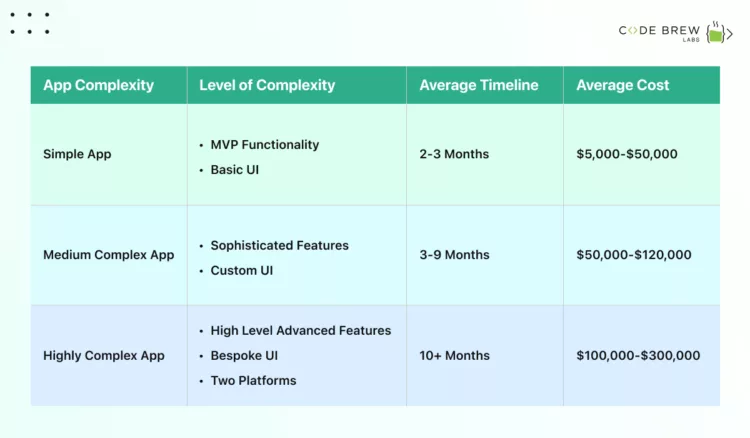
A simple app comprises of basic user features like a login system, user profile facility, dashboard, and limited administration.
A medium-complex app includes a wide range of features for user engagement and app monetization. Besides basic features, these apps include social media integrations, audio/video streaming, payment gateway, user privacy, etc.
Meanwhile, complex apps are integrated with the latest technologies like AR/VR, AI, and Machine learning. Such apps also include features like multi-language support, high-end data logic, and so much more.
With so many smartphone owners today, it can be easy to forget that mobile apps are relatively new. But since the early 1970s–when the first mobile phone was introduced–mobile app development has gone through a massive number of changes while changing our lives immeasurably!
And with emerging technologies like AI, VR, AR, and blockchain disrupting the industry, there aren’t any signs of mobile app development slowing down anytime soon.
In fact, the numbers speak for themselves: By 2026, mobile applications are projected to generate $233 billion in revenue.
And that, it seems, is a big indicator of the perks of mobile app development.
The developers at Code Brew Labs have years of experience building state-of-the-art mobile applications for all platforms. We take extra care to fully understand your business needs and craft a tech solution that truly works for you.
If you’re looking for a reliable mobile app development company that builds nothing but the best products, we’re definitely a catch! Talk to us now.
